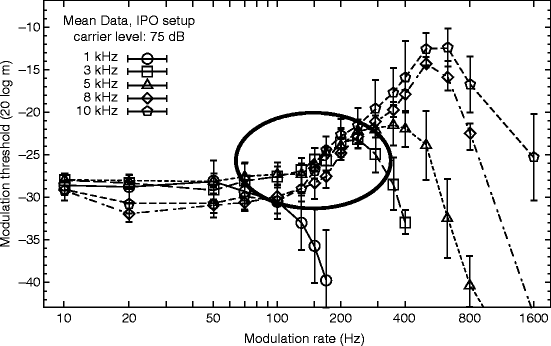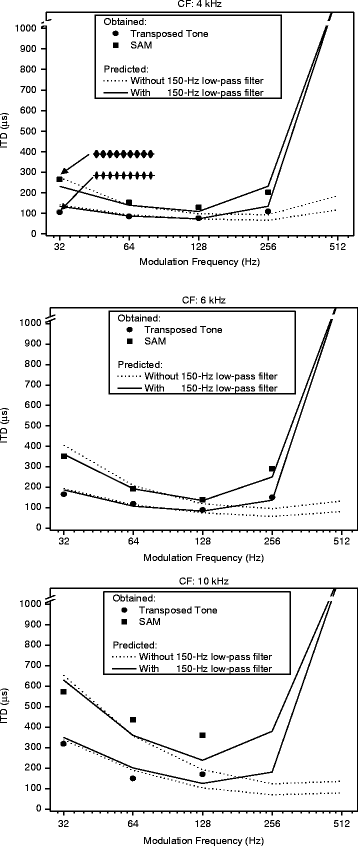Fig. 30.1
Threshold ITD as a function of envelope-rate or noise bandwidth for stimuli centered at 4 kHz (upper panel) or 8 kHz (lower panel) (Adapted with permission from Bernstein and Trahiotis (1994). Copyright 1994, Acoustical Society of America)
In general, the results replicate the findings of the earlier studies in that resolution of ITDs is greatly degraded and/or rendered impossible (data plotted as Xs) for rates of modulation of about 250 Hz and higher. This occurs similarly for SAM tones and two-tone complexes even though, for a given rate of modulation, the spectral separation of the “sidebands” of the two-tone complexes is half that of the SAM tones. Of particular importance here is the finding that the rate of modulation above which threshold ITDs increase is substantially lower for stimuli centered at 8 kHz than for stimuli centered at 4 kHz. This result is the opposite of what one would expect if attenuation of spectral components via peripheral auditory filtering were responsible for the rate-limitation. This is so because the auditory filter centered at 8 kHz is roughly twice as wide as the one centered at 4 kHz. Note that a rate-limitation was not evident for ITDs conveyed by the envelopes of bands of noise. This is expected because, unlike the case for the spectrally discrete stimuli, increasing the bandwidth of noise beyond one auditory filter would not be expected to alter the internal representation of the envelope of the continuous-spectrum noise passed by that filter. Thus, threshold ITDs would not be expected to increase as the bandwidth of a noise is increased. On the contrary, threshold ITDs would be expected to, if anything, become smaller to the degree that independent information concerning ITD could be accrued across separate filters. The data obtained at both center frequencies do, in fact, exhibit such a decline.
Three subsequent studies, Kohlrausch et al. (2000), Ewert and Dau (2000), and Moore and Glasberg (2001), showed that an envelope rate-limitation also affects processing of envelope fluctuations at high spectral frequencies when the cues are monaural rather than binaural. In those studies, temporal modulation transfer functions (TMTFs) were measured at various center frequencies. The patterning of the data and their quantitative analyses led Kohlrausch et al. (2000) and Ewert and Dau (2000) to include in their modeling a low-pass filter that attenuates, independent of the center frequency of the stimulus and, correlatively, independent of the width of the auditory filter, fluctuations of the envelope that are more rapid than 150 Hz. Representative TMTF data taken from Kolhraush et al. are shown in Fig. 30.2. The superimposed oval highlights the region of the data demonstrating the rise of the thresholds associated with increases in the rate of modulation.


Fig. 30.2
TMTFs as a function of center frequency (Reprinted with permission from Kohlrausch et al. (2000). Copyright 2000, Acoustical Society of America)
It remained to be seen whether the incorporation of such an envelope low-pass filter into a comprehensive cross-correlation-based model of binaural hearing would provide a quantitative accounting of the rise in threshold ITDs observed for high rates of modulation. To that end, Bernstein and Trahiotis (2002) measured threshold ITDs for SAM tones and transposed tones centered at 4, 6, or 10 kHz while varying rate of modulation. Their results, averaged across four listeners, are shown in Fig. 30.3 as solid symbols. Note that, while listeners were consistently more sensitive to changes in ITD conveyed by the transposed tones, the rates of modulation beyond which thresholds ITDs increased were essentially the same for the two types of stimuli at each center frequency. That outcome notwithstanding, as indicated by the threshold ITDs obtained at a rate of modulation of 256 Hz, the “limiting” rate of modulation appears to have decreased as center frequency increased, in line with the results of Bernstein and Trahiotis (1994). In fact, at that rate of modulation, the listeners were unable to perform the task when the center frequency was 10 kHz even for ITDs as large as 1 ms.


Fig. 30.3
Threshold ITDs as a function of modulation frequency for SAM and transposed tones centered at 4, 6, or 10 kHz (Adapted with permission from Bernstein and Trahiotis (2002). Copyright 2002, Acoustical Society of America)
The dotted lines in each panel of Fig. 30.3 represent predictions of a general cross-correlation-based model (e.g., Bernstein and Trahiotis 2002) that does not incorporate the envelope low-pass filter of interest. Those predictions can be used to evaluate Nuetzel and Hafter’s (1981) notion that peripheral auditory filtering degrades resolution of ITDs at high rates of modulation by attenuation of the “sidebands” of the stimulus. Consistent with that view is the small rise in predicted threshold ITDs at rates of modulation ≥256 Hz for stimuli centered at 4 kHz and progressively smaller rises in predicted threshold ITDs at 6 and 10 kHz, respectively. Although such a model does a fairly good job of predicting threshold ITDs for both types of stimuli at low and moderate rates of modulation, it fails to predict the magnitude of the increases in threshold ITD at high rates of modulation at any of the center frequencies tested.
The solid lines represent predicted threshold ITDs derived from the cross-correlation-based model after it was augmented to include a 150-Hz low-pass envelope filter as suggested by Kohlrausch et al. (2000). As is evident from the figure, including the low-pass filter resulted in predictions that are much more accurate and even successfully predict when the task could not be performed at center frequencies of 4 and 6 kHz. A failure of the model is its prediction that the task could have been performed at a rate of modulation of 256 Hz for the 10-kHz-centered stimuli. As indicated by the absence of data points for this condition, the task could not be performed. The model’s failure is a consequence of the underlying (apparently false) assumption that the cutoff frequency of the envelope low-pass filter is independent of center frequency in tasks measuring threshold ITDs. That assumption runs counter to the patterning of the data in Fig. 30.3 and to the patterning of the data in Fig. 30.1.
Stay updated, free articles. Join our Telegram channel

Full access? Get Clinical Tree


